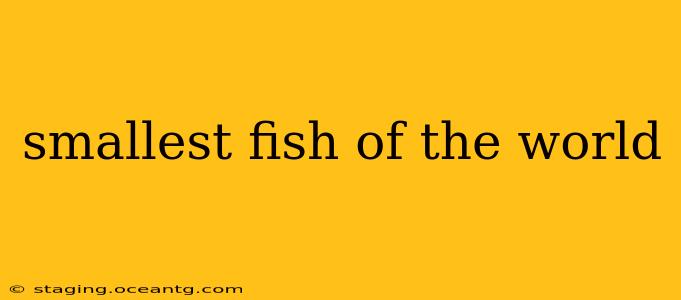The quest for the world's smallest fish is a fascinating dive into the intricacies of the aquatic world. While pinning down a definitive "smallest" is tricky due to variations in species and measurement techniques, several contenders vie for the title, showcasing nature's incredible miniature artistry. This exploration will delve into some of the leading candidates and address common questions surrounding these microscopic marvels.
What is the smallest fish in the world?
Several species compete for the title of the world's smallest fish, and the answer often depends on the specific measurement used (length versus weight). Currently, the dwarf goby (Trimmatom nanus) is frequently cited as a strong contender. This tiny fish measures just around 8-10 millimeters (0.3-0.4 inches) in length. Its diminutive size belies its remarkable adaptations to survive in the coral reefs of the western Indian Ocean.
What are some other tiny fish species?
While the dwarf goby often takes center stage, other remarkably small fish deserve recognition:
-
Paedocypris progenetica: This species, found in peat swamps in Sumatra, Indonesia, was once considered the smallest vertebrate. While its exact size is debated, some specimens measured less than 8 millimeters. It's crucial to note that the species' survival is threatened by habitat loss.
-
Schindleria brevipinguis: Another contender from the deep, this tiny fish, found in the waters surrounding Australia, boasts a length that rivals the dwarf goby. Its overall size and body shape also contribute to its status as one of the smallest fish.
How are these tiny fish discovered and studied?
Discovering and studying these microscopic marvels presents unique challenges. Scientists often rely on specialized equipment, including fine-meshed nets and high-powered microscopes, to collect and analyze specimens. Their delicate nature also requires careful handling and preservation techniques. Furthermore, their habitat, often remote and challenging to access, adds to the complexity of research. Genetic analysis is frequently used to differentiate species and understand their evolutionary relationships.
Where do these tiny fish live?
The habitats of these minuscule fish vary. The dwarf goby prefers the coral reefs of the western Indian Ocean, highlighting the importance of coral reef conservation for their survival. Other species, like Paedocypris progenetica, inhabit specific freshwater environments, such as peat swamps, making them particularly vulnerable to environmental changes. Understanding their precise habitat preferences is crucial for effective conservation efforts.
Are these tiny fish important to the ecosystem?
Despite their small size, these fish play a vital role in their respective ecosystems. They serve as a food source for larger predators, contributing to the intricate food web. Their presence also reflects the overall health and biodiversity of their habitat. A decline in their numbers could signal broader environmental issues. Further research is needed to fully grasp their ecological significance.
What are the threats to these tiny fish?
Habitat destruction, pollution, and climate change pose significant threats to these miniature creatures. The destruction of coral reefs, for instance, directly impacts the dwarf goby's survival. Likewise, pollution and changes in water quality threaten the delicate freshwater ecosystems where other species thrive. Conservation efforts are critical to protect these fascinating fish and their fragile habitats.
This exploration into the world's tiniest fish sheds light on the remarkable diversity and adaptability of life in our oceans and freshwater systems. Further research and conservation efforts are crucial to ensure the survival of these miniature marvels and their invaluable contributions to the planet’s biodiversity.
